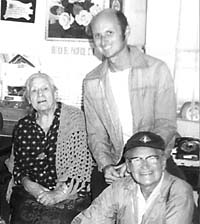 The year was 1974, seven years before her death, when I first met Mrs.
Villa. My father and I were touring Copper Canyon, and we were introduced
to her at her home in the city of Chihuahua.
The year was 1974, seven years before her death, when I first met Mrs.
Villa. My father and I were touring Copper Canyon, and we were introduced
to her at her home in the city of Chihuahua. Sharing her memories with us, eighty-two year old Doña Luz told us of her life as a child, living with her widowed mother in the town of San Andres. One day, when she was a teenager, Villa and his soldiers rode in and demanded monetary contributions from the townspeople. Her mother asked to be excluded, and Villa visited her small store to see if she was really as poor as she claimed to be. There he met Luz. The courtship was very brief, and over the objections of her mother, Luz married Villa. The attending priest asked Villa to make his confession. The General refused, stating that it would take days to list all his sins.
Luz was not the only woman in Villa's life. He was linked with several in bogus marriages, but later Luz was able to produce a valid certificate proving that she was his only legal wife.
The couple had one child, a daughter, who died within a few years. Luz had no other children, but she took in children Villa had fathered with other women. Perhaps she felt that he would always return to her, knowing that several of his children were with her. Villa built the quinta (manor) during the Revolution, and Luz lived there until her death in 1981. Villa was assassinated in 1923, and several of his “wives” claimed the manor. The marriage certificate might not have been sufficient to safeguard her claim, but Luz had an important ally, Alvaro Obregon, President of Mexico. During the Revolution, Obregon had visited the Villas at the quinta. There Villa had plotted to have Obregon killed, but Luz had interceded, saving the future president's life. The favor was not forgotten, and Obregon used his considerable influence to protect Luz's claim.
Eventually the house became a museum, with Luz the resident caretaker, and she tried personally to meet each visitor. Luz traveled through Mexico and the United States, and in Los Angeles received the key to the city.
Shortly before her death she wrote a book about her life with Villa, Pancho Villa: an Intimacy, published by Centro Librero La Prensa, in the city of Chihuahua. In it she loyally defends Villa against most of the accusations against him for his many excesses while leading the Army of the North. While this book must be read with a skeptical eye, her account provides interesting insights into Villa and the Revolution.
Click Here for information on our Copper Canyon Tours.


